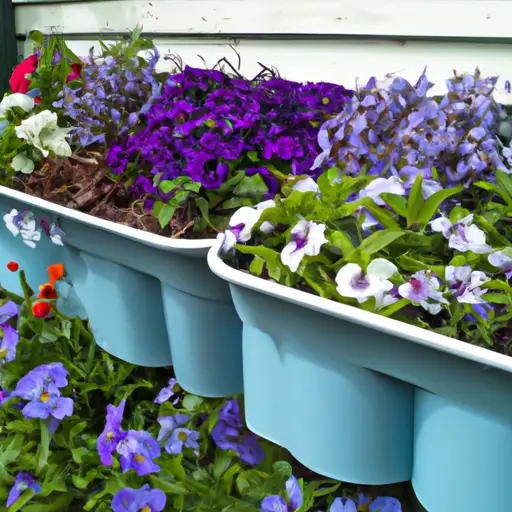Container Gardening: A Small-Space Solution for Garden Lovers
When it comes to gardening, one might think that having a sprawling yard or ample outdoor space is essential. However, with the rise of urban living and smaller living spaces, many garden enthusiasts find themselves without a backyard to cultivate their green thumbs. But fear not, for container gardening is here to save the day! Container gardening offers an innovative and practical solution for garden lovers with limited space. In this article, we will explore the benefits of container gardening, tips for getting started, and some creative ideas to inspire your own small-space oasis.
Container gardening involves growing plants in pots or containers rather than directly in the ground. This method allows individuals with balconies, patios, or small yards to create beautiful and productive gardens within the confines of their limited space. The concept of container gardening has been around for centuries but has gained popularity in recent years due to its versatility and convenience.
One of the major advantages of container gardening is its flexibility. Unlike traditional gardens that require extensive planning and landscaping, container gardens allow you to create a customized space by selecting containers of various sizes, shapes, and colors. From classic clay pots to modern hanging baskets or repurposed items like old buckets or tires – the possibilities are endless!
Another benefit of container gardening is portability. Unlike conventional gardens that are fixed in one location, containers can be easily moved around according to your needs. If you live in an apartment and need more sunlight for your plants during different seasons or times of day, you can simply relocate your containers accordingly.
Container gardening also offers greater control over soil conditions. By using high-quality potting soil mixes tailored to specific plant needs, you can ensure optimal nutrition and drainage for your plants’ health and growth. This control over soil composition is particularly advantageous if you live in an area with poor soil quality or if you want to grow plants requiring specific pH levels.
For beginners, container gardening is an excellent entry point into the world of horticulture. It allows you to start small with just a few pots and gradually expand your collection as you gain experience and confidence. Moreover, container gardening requires less maintenance compared to traditional gardens. With fewer weeds to contend with and plants contained in pots, the time spent watering, pruning, and fertilizing is significantly reduced.
Now that we have explored the benefits of container gardening, let’s dive into some practical tips for getting started. Firstly, it is important to consider the available sunlight in your space. Most flowering plants require at least six hours of direct sunlight daily, while herbs and leafy greens can thrive with slightly less sun exposure. Assess your balcony or patio’s orientation and choose plants accordingly.
Next, choose containers that are appropriate for your selected plants. Ensure that each container has proper drainage holes to prevent waterlogging and root rot. Additionally, consider the size of the containers in relation to the growth potential of your plants. Large containers work well for fruit trees or deep-rooted vegetables while smaller ones are suitable for herbs or compact flowers.
Selecting high-quality potting soil is crucial for successful container gardening. Invest in soil mixes that contain organic matter such as compost or peat moss for enhanced nutrient availability and moisture retention. Remember to fertilize regularly since potted plants often exhaust nutrients more quickly than those grown in the ground.
Watering is another important aspect of container gardening. The frequency and amount of water needed vary depending on plant type, pot size, temperature, and humidity levels. Properly hydrate your plants by checking the moisture level at least once a day during hot weather or dry conditions.
Lastly, keep an eye out for pests and diseases that can impact your container garden. Inspect leaves regularly for signs of damage or infestation such as holes or sticky residue left by sap-sucking insects like aphids or mealybugs. Early detection and intervention can prevent major issues and ensure the health of your plants.
With the basics of container gardening covered, let’s explore some creative ideas to inspire your own small-space oasis. Vertical gardens are an excellent way to maximize limited space. Use hanging baskets or wall-mounted planters to create a living wall of cascading flowers or trailing vines – an instant eye-catcher!
If you have a balcony railing, utilize window boxes or railing planters to add a touch of vibrant color without taking up valuable floor space. These containers are perfect for growing herbs, colorful annuals, or even small vegetables like cherry tomatoes or peppers.
For those with no outdoor area whatsoever, indoor container gardening is the answer. Utilize windowsills, countertops, or shelves that receive adequate natural light for plants like succulents, cacti, or herbs. Hanging pots can also be used to add greenery and life to any room while conserving valuable floor space.
In conclusion, container gardening is the perfect solution for garden lovers with limited outdoor space. With its flexibility, portability, and control over soil conditions, anyone can create a beautiful and productive garden within the confines of their small living space. By following some basic tips and getting creative with various containers and plant choices, you can transform your balcony, patio, or even indoor area into a lush sanctuary that brings joy and rejuvenation year-round. So don’t let limited space hold you back – start container gardening today!














